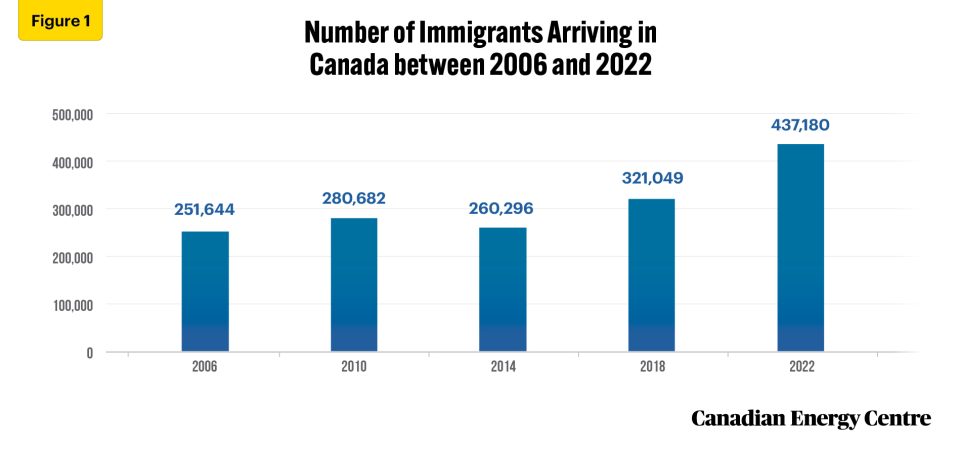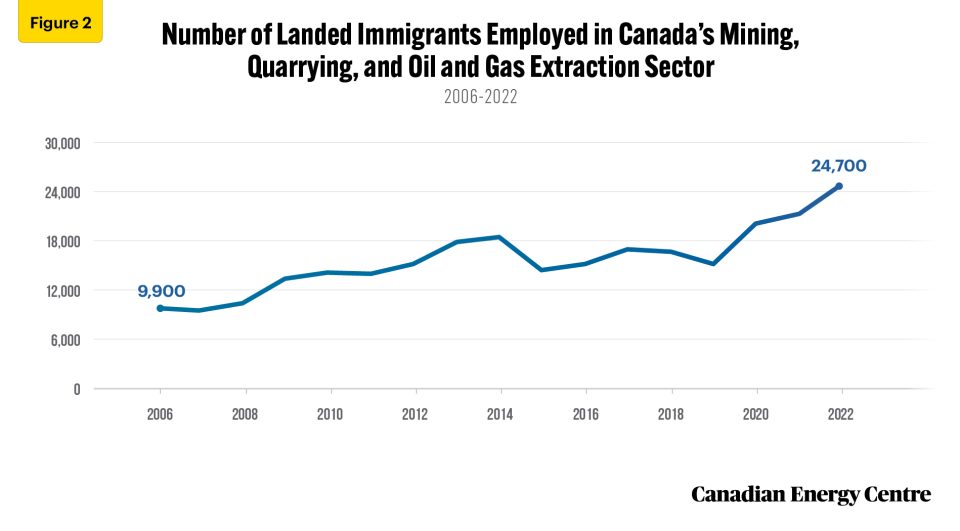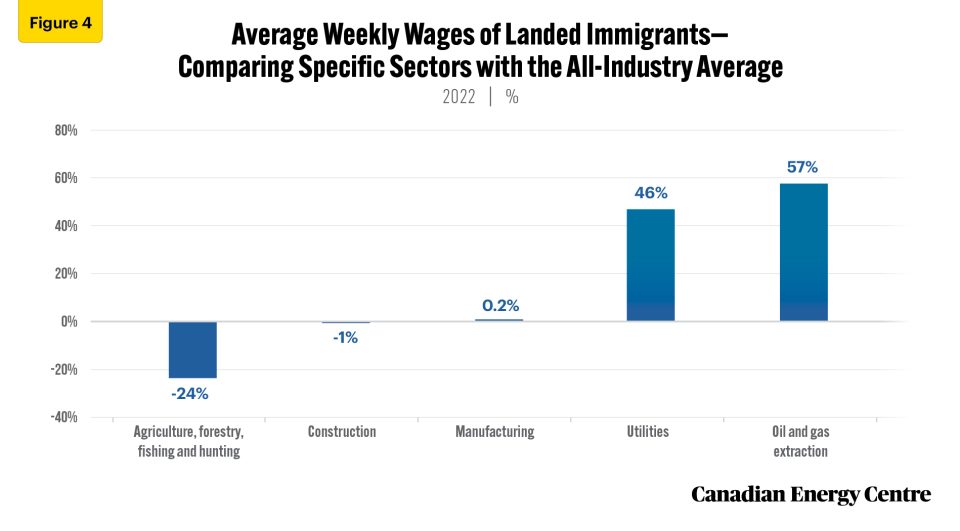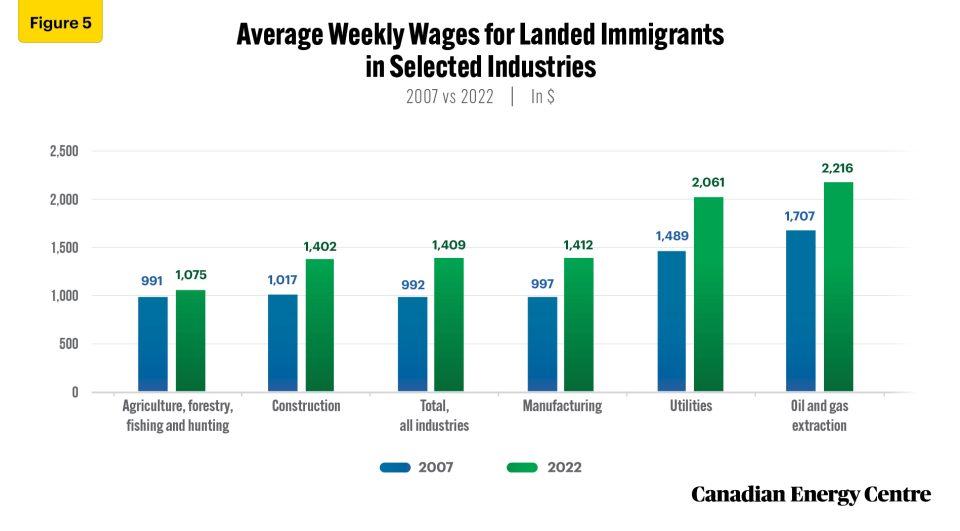The number of landed immigrants working in Canada’s oil and gas sector has generally grown over the last 15 years
By Ven Venkatachalam and Lennie Kaplan
Follow CEC on Linkedin CEC Linkedin
Follow CEC on Facebook CEC Facebook
Follow CEC on Twitter CEC Twitter

CMR Fabricators Ltd. quality control inspector Ram Lakshmanan checks pipe at the company facility in Penhold, Alberta. Tuesday, March. 9th, 2021. CANADIAN ENERGY CENTRE/Dave Chidley
Introduction
Canada has a long history of immigration. Immigrants make up the largest share of Canada’s population: almost one in four of its people (23 per cent) are or have been a landed immigrant or a permanent resident.
Immigration has had an enormous impact in all developed countries, including Canada. Canada has one of the world’s highest immigration rates, averaging about one per cent of its total population each year. Between 2006 and 2022, the number of immigrants moving to Canada increased by 74 per cent—about 4.8 million people in total. In 2022 alone, about 437,180 immigrants arrived in the country (see Figure 1).
In the past decade, the characteristics of people immigrating to Canada has changed significantly. Immigrants to Canada are more diverse than ever before.
Immigrants moving to Canada have found work in many of the country’s industries, including the oil and gas extraction and mining sectors. In this Fact Sheet, we examine employment trends and incomes for landed immigrants working in Canada’s resource sector (which includes the mining and oil and gas extraction sector) between 2006, the earliest year of available comparable data, and 2022.¹
1. For the purposes of tracking economic progress, Statistics Canada defines a landed immigrant as someone to whom the immigration authorities have granted the right to live in Canada permanently. Canadian citizens by birth and non-permanent residents (people from another country who live in Canada and have a work or study permit or are claiming refugee status and have family members living here with them), are not considered landed immigrants

Source: Statistics Canada, Table 17-10-0040-01.
Statistics Canada data show that participation by landed immigrants in Canada’s mining, quarrying, and oil and natural gas extraction sector has for the most part increased since 2006. In 2022, the sector employed 24,700 landed immigrants (see Figure 2).

Source: Derived from Statistics Canada, Labour Force Survey, custom tabulation.
Landed immigrants employed in the oil and gas extraction sector are paid more than those working in other goods-producing industries—and more than the average for landed immigrants in all industries combined.
In 2022, the average weekly wage for landed immigrants ranged from $1,075 for those employed in agriculture, forestry, fishing, and hunting to $2,216 for those in the oil and gas extraction sector. By comparison, the all-industry average weekly wage for landed immigrants was $1,409 (see Figure 3).

Source: Derived from Statistics Canada, Labour Force Survey, custom tabulation.
Expressed as percentages, in 2022, the average weekly wage for landed immigrants in the oil and gas sector was also higher than for those in selected other sectors and the all-industry average. Immigrants in agriculture, forestry, fishing, and hunting earned 24 per cent less than the all-industry average; those in the manufacturing and construction earned virtually the same as that average; and immigrants working in the utilities sector earned 46 per cent more. Meanwhile, those working in the oil and gas extraction sector earned 57 per cent more than the all-industry average (see Figure 4).

Source: Derived from Statistics Canada, Labour Force Survey, custom tabulation.
Between 2007 and 2022, average weekly wages for landed immigrants employed in the oil and gas extraction sector grew from $1,707 to $2,216, an increase of nearly 30 per cent (see Figure 5).

Source: Derived from Statistics Canada, Labour Force Survey, custom tabulation.
Conclusion
Statistics Canada Labour Force Survey data show that landed immigrants in Canada benefit from their participation in the oil and gas extraction sector. The number of landed immigrants employed in the sector has generally grown over the past 15 years. The average weekly earnings for landed immigrants working in the sector are higher than for other goods-producing industries and the average of all other sectors.
Notes
This CEC Fact Sheet was compiled by Ven Venkatachalam and Lennie Kaplan at the Canadian Energy Centre (www.canadianenergycentre.ca). All percentages in this report are calculated from the original data, which can run to multiple decimal points. They are not calculated using the rounded figures that may appear in charts and in the text, which are more reader friendly. Thus, calculations made from the rounded figures (and not the more precise source data) will differ from the more statistically precise percentages we arrive at using source data. The authors and the Canadian Energy Centre would like to thank and acknowledge the assistance of two anonymous reviewers in reviewing the data and research for the initial edition of this Fact Sheet.
Reference (as of June 27, 2023)
Canada (2022), New immigration plan to fill labour market shortages and grow Canada’s economy <https://bit.ly/3OQdg7x>; Statistics Canada (2022a), Immigrants make up the largest share of the population in over 150 years and continue to shape who we are as Canadians <https://tinyurl.com/2dk55sr3>; Statistics Canada (2022b), Table 17-10-0040-01: Estimates of the components of international migration, quarterly <https://bit.ly/3nJAvEu>; Statistics Canada (2023), Labour Force Survey, 0421_11 Table 1 <https://bit.ly/3c1sd8x> (Custom tabulation).
Creative Commons Copyright
Research and data from the Canadian Energy Centre (CEC) is available for public usage under creative commons copyright terms with attribution to the CEC. Attribution and specific restrictions on usage including non-commercial use only and no changes to material should follow guidelines enunciated by Creative Commons here: Attribution-NonCommercial-NoDerivs CC BY-NC-ND.
Share This:




